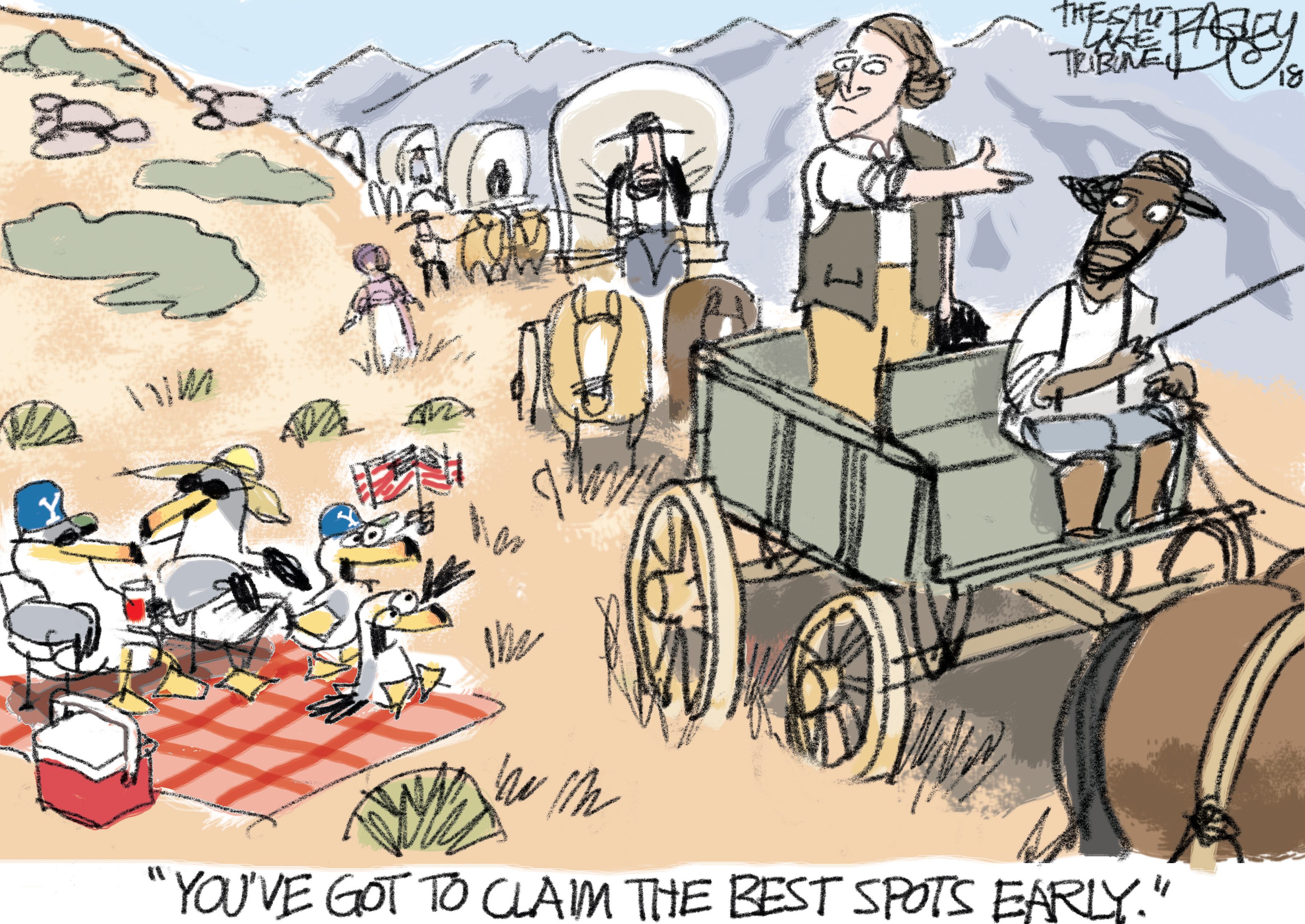It was perhaps not a big deal for Dan Reynolds, the Imagine Dragons frontman, to sell out a stadium in Utah County last summer for a concert. But Reynolds, a devout member of the Mormon church, knew what an accomplishment it was to get 17,000 people there for a show whose purpose was to generate awareness and support for LGBTQ youths.
Reynolds also knows that, successful as 2017’s LoveLoud Festival was, it couldn’t be a one-time event if he wants to make a legitimate difference.
“It did a really good job of starting a conversation and getting the ball rolling,” Reynolds told The Salt Lake Tribune, “but we have a long ways to go and a lot of work to be done.”
So the LoveLoud Festival is back, this year without the endorsement from the LDS Church that the first event had — a change that Reynolds said contributes to his pessimism about change in the church.
The festival moved this year to the 45,000-capacity Rice-Eccles Stadium in Salt Lake City. The half-day series of speakers and musical performers takes place Saturday, beginning at 3:30 p.m. Tickets range from $29.50 to $99.50, and Reynolds’ LoveLoud Foundation said proceeds will go toward raising $1 million to benefit local and national LGBTQ charities, including Encircle, The Trevor Project, and the Tegan and Sara Foundation.
Stephenie Larsen, Encircle’s founder and CEO and a board member of the LoveLoud Foundation, said last year’s event was an incredible experience.
“I was sitting there thinking, ‘Is this really happening in my hometown?’ You could not have left that concert without feeling uplifted and like your life had changed forever,” Larsen said. “I think it will have a similar impact [this year]. I really think people will look at LGBTQ individuals in a more positive way.”
There will be musical performances by Imagine Dragons, EDM star Zedd, Linkin Park’s Mike Shinoda, teen singer-songwriter Grace Vanderwaal and Neon Trees frontman Tyler Glenn. The myriad other speakers and performers include Apple CEO Tim Cook, dancer Julianne Hough and singer Tegan Quin.
‘Not the most positive answer’
Reynolds started LoveLoud for one simple reason: “Our LGBT youth — statistics and evidence show that they are some of the most at-risk.”
![(Rick Egan | The Salt Lake Tribune) Dan Reynolds sings for Imagine Dragons at the inaugural LoveLoud Festival at Brent Brown Ballpark at UVU campus, Saturday, Aug. 26, 2017.]() (Rick Egan | The Salt Lake Tribune) Dan Reynolds sings for Imagine Dragons at the inaugural LoveLoud Festival at Brent Brown Ballpark at UVU campus, Saturday, Aug. 26, 2017.
(Rick Egan/)
(Rick Egan | The Salt Lake Tribune) Dan Reynolds sings for Imagine Dragons at the inaugural LoveLoud Festival at Brent Brown Ballpark at UVU campus, Saturday, Aug. 26, 2017.
(Rick Egan/)A Centers for Disease Control and Prevention study released last November reported that Utah’s suicide rate among young adults ages 10 to 17 had more than doubled from 2011 to 2015 and had grown at an annual clip nearly four times faster than the national average. A study by the Family Acceptance Project concluded that “lesbian, gay and bisexual youth who come from highly rejecting families are 8.4 times as likely to have attempted suicide as peers who reported no or low levels of family rejection.”
The Church of Jesus Christ of Latter-day Saints, a Utah-based faith, teaches that while being gay is not a sin, acting on it is. It opposes gay marriage, and in 2015 put forth a policy that labeled same-sex Mormon couples “apostates” and barred their offspring from religious rituals such as baptism until they turn 18.
Even if there’s not direct causation there, Larsen said, there’s undoubtedly correlation.
“Kids, on average, realize they’re gay at 12, but they don’t come out ’til 22. In that decade, they’re hearing nothing but negativity about who they are, and getting nothing but shame and isolation from family and friends,” she said. “No wonder they become suicidal.”
The LDS Church has taken what some see as positive steps within the past year to address the issue.
Last summer, the church approached Reynolds with the offer of an endorsement for LoveLoud and posted a statement of support on its newsroom website. In June, the Mormon Tabernacle Choir joined forces with the San Francisco Gay Men’s Chorus for a performance in Mountain View, Calif. And earlier this month, the LDS Foundation, the charitable division of the Mormon church, donated $25,000 to Affirmation, an LGBTQ support group, to pay for suicide prevention training.
While Reynolds said he’d had conversations with church officials about another endorsement (“I plead with them to do so. I think that it’s essential for creating safer homes within the Mormon community,” he said), the church later declined.
It instead issued a general statement — which did not refer to LoveLoud by name — saying, in part: “We remain committed to support community efforts throughout the world to prevent suicide, bullying and homelessness. Every young person should feel loved and cared for in their families, their communities and their congregations.”
Asked about its decision not to offer a specific endorsement this year, the church said its comments would be limited to the statement.
Asked if he saw genuine progress coming from his church, Reynolds was blunt in his pessimism.
“I think that it’s small steps. Do I feel like the church has made any large steps? I’d be lying to you if I told you I thought so,” he said. “… I do believe Mormons are having this conversation in their homes, because it’s unavoidable. And that has been the goal, to make it [so ubiquitous] in the press that Mormons are faced with having to have this conversation at the dinner table.
“It’s not the most positive answer,” Reynolds added dejectedly. “We’re making small steps, but it’s frustrating because small steps just don’t seem enough when we’re losing kids every month. And that’s the reality of it right now. … We have a long ways to go, and not a lot of time.”
Larsen did not criticize Affirmation’s acceptance of the church’s donation — a decision that prompted its vice president to resign in protest — but she said Encircle wouldn’t follow suit: “We never want to take [the church’s] money, because it’s a PR stunt.”
While church President Russell M. Nelson receiving imminent divine revelation to change existing doctrine regarding same-sex relationships is unlikely, that doesn’t make the status quo any less untenable, Larsen said.
![(Rick Egan | The Salt Lake Tribune) Stephenie Larsen talks about the new Encircle family and youth resource center that will open in Salt Lake City later this year. Friday, Feb. 2, 2018.]() (Rick Egan | The Salt Lake Tribune) Stephenie Larsen talks about the new Encircle family and youth resource center that will open in Salt Lake City later this year. Friday, Feb. 2, 2018. (Rick Egan/)
(Rick Egan | The Salt Lake Tribune) Stephenie Larsen talks about the new Encircle family and youth resource center that will open in Salt Lake City later this year. Friday, Feb. 2, 2018. (Rick Egan/)“Without a big step, these individuals will be second-class citizens within their church and community,” she said. “For someone to be told that their nature goes against God is extremely traumatic and damaging.”
‘Break the cycle’
In the meantime, she, Reynolds and Quin view LoveLoud as a way to help make up for some of that through its awareness campaign and fundraising efforts.
Quin and her identical twin sister are the Canadian pop band Tegan and Sara. Both sisters identify as LGBTQ, and they founded the Tegan and Sara Foundation to fight for health, economic justice and representation for LGBTQ girls and women.
When Reynolds reached out to Tegan Quin to see if the group would perform at LoveLoud, she made a counteroffer — she’d help him organize and book the event.
“The more Dan and I talked about it, the more I wanted to be bossy and insert myself and be involved,” Quin said. “I see a lot of parallels between the work LoveLoud is doing and the compassion that they’re trying to push into the community and the work we do with our foundation. So I’m really excited to be involved.”
Larsen said making the populace at large better informed of what’s at stake is paramount.
“What are we doing as a community and as a state to make them think their lives are not worth living? Until we shine a light on the causes, we’re going to have these problems,” she said. “There’s nothing about being gay that inherently makes you suicidal. The community you grow up in and the messages they send you is what makes you feel suicidal.”
Listening to LoveLoud’s speakers, and not just its musical performers, is the perfect way to spread that message, Reynolds said.
“To have people like my parents out in the crowd who maybe have never sat down and listened to someone from the trans community tell their story, that could be life-changing for them,” he said.
“People getting up and sharing their stories, and the conversation that’s happening — you’d have to have a piece of coal in your heart to not be moved and feel some empathy and compassion,” Quin agreed.
![(Owen Sweeney/Invision/AP) Tegan Quin, front, and Sara Quin of the band Tegan and Sara perform in concert during their Love You to Death Tour at The Fillmore in Philadelphia on Thursday, Nov. 3, 2016.]() (Owen Sweeney/Invision/AP) Tegan Quin, front, and Sara Quin of the band Tegan and Sara perform in concert during their Love You to Death Tour at The Fillmore in Philadelphia on Thursday, Nov. 3, 2016. (Owen Sweeney/)
(Owen Sweeney/Invision/AP) Tegan Quin, front, and Sara Quin of the band Tegan and Sara perform in concert during their Love You to Death Tour at The Fillmore in Philadelphia on Thursday, Nov. 3, 2016. (Owen Sweeney/)
She added that while “Dan was already coming at it straight from his heart, which is a great place to come at it from,” she would like to see future LoveLouds expand representation and increase diversity.
Reynolds said this year’s LoveLoud has already outsold last year’s, and he’s hoping, ultimately, it can double the first incarnation’s attendance figure.
In the meantime, he remains — like the title of his Sundance- and HBO-featured documentary — a “Believer.” A believer in the fundamental goodness of humanity, and a believer that being LDS and LGBTQ need not be inherently incompatible.
“I think people are starting to say enough is enough. I believe in the hearts of Mormons, I believe we’re good people and we want to love fully, and sometimes that can just be difficult to do, especially if we’re being taught different things in our church and communities and we’re raised with those things,” Reynolds said. “So I hope we can break the cycle.”
If you or someone you know is struggling with depression or suicidal thoughts, call The Trevor Project at 866-488-7386, or visit its website, where you can talk to someone via text or chat.






























